Indonesian Journal of Clinical Pathology and Medical Laboratory
ISSN 0854-4263
Vol. 19 / No. 1 / Published : 2012-01
Related with : Scholar Yahoo! Bing
Original Article :
Antimicrobial sensitivity of blood culture in neonatal sepsis
Author :
- Tajuddin Noor*1
- Nurhayana Sennang*2
- Benny Rusli*3
- Bag PK FK-UNHAS Makassar
- Bag PK FK-UNHAS Makassar
- Bag PK FK-UNHAS Makassar
Abstract :
Sepsis was one of the morbidity and mortality causes in neonatal. The diagnosis and treatment requires the bacterial identification and selection of sensitive antimicrobials. The aim of this study was to know the bacterial pattern and antimicrobial sensitivity of blood culture in the suspected neonatal sepsis patients who were treated at NICU in Dr.Wahidin Sudirohusodo Hospital Makassar. A retrospective study was conducted with secondary data from the culture and antimicrobial susceptibility test between the period of June 2010-July 2011. In this present study was found that from the total 91 blood culture isolates, bacteria Gram-negative group was 85.7% and Gram-positive was 14.3% and the isolate encountered in order of frequency were Alkali genes faecalis 50.5%, Klebsiella pneumonia 25.3%, and Staphylococcus epidermidis 9.9%. In the Gram-negatives group, the isolate often encountered were Alkali genes faecalis 59.0%, Klebsiella pneumonia 29.4% and Enterobacter spp 6.4% while in the Gram-positive group were found Staphylococcus epidermidis 69.2% and Staphylococcus saprophytic 23.1%. The more sensitive antimicrobal that belong to Gram-negative group were Meropenem 94.4%, Levofloxacin 92.1%, and Ceftazidime 77.0% while the more resistant were Ampicillin 94.6%, Gentamycin 89.1% and Cefuroxime 82.7%. The more sensitive antimicrobal that belong to Gram-positive group were Vancomycin and Chloramphenicol 91.7% and Novobiosin 76, 9% while the more resistant were Gentamycin and Ceftriaxone 100.0% and Amoxicillin 91.7%. Based on this study it can be concluded that Gram-negative aerobe bacteria was more common than the Gram-positive one. Meropenem, Levofloxacin and Ceftazidime antimicrobal were high sensitive to Gram-negative while Vancomycin, Chloramphenicol, and Novobiocin were high sensitive to Gram-positive. The resistance of Ampicillin and Gentamycin were found in both bacterially groups of sepsis suspected neonatal patients in NICU. Penularan penyakit ke seluruh tubuh (sepsis) merupakan salah satu penyebab angka kesakitan dan angka kematian bayi baru lahir (neonatal). Diagnosis dan pengobatan memerlukan pengenalian bakteri dan pemilihan antibiotika yang peka. Penelitian ini bertujuan untuk mengetahui pola bakteri dan kepekaan antimikroba kultur darah penderita yang dirawat di ruang NICU RS.Dr.Wahidin Sudirohusodo Makassar dan diduga sepsis neonatal. Cara meneliti adalah tinjauan ke belakang yaitu pengamatan data sekunder hasil uji kultur dan kepekaan antimikroba dalam masa waktu antara bulan Juni 2010-Juli 2011. Didasari hasil telitian diperoleh data yaitu dari jumlah keseluruhan 91 isolat kultur darah ditemukan golongan bakteri Gram-negatif 85,7% dan Gram-positif 14,3% dengan urutan bakteri terbanyak adalah Alkaligenes faecalis 50,5%, Klebsiella pneumoniae 25,3%, dan Staphylococcus epidermidis 9,9%. Di golongan Gram-negatif, bakteri terbanyak ialah Alkaligenes faecalis 59,0%, Klebsiella pneumoniae 29,4% dan Enterobacter spp 6,4% dan di golongan Gram-positif, bakteri terbanyak ialah Staphylococcus epidermidis 9,2% dan Staphylococcus saprofiticus 23,1%. Kepekaan antimikroba terhadap bakteri Gram-negatif urutan tertinggi adalah Meropenem 94,4%, Levofloxacin 92,1% dan Ceftazidime 77,0% dan resistensi Ampicillin 94,6%, Gentamycin 89,1% dan Cefuroxime 82,7%. Kepekaan antimikroba terhadap bakteri Gram-positif tertinggi adalah Vancomycin dan Chloramphenicol 91,7% dan Novobiosin 76,9%, sedangkan resistensi Gentamycin, Ceftriaxone 100,0% dan Amoxicillin 91,7%. Simpulan telitian ini adalah bahwa golongan bakteri aerob Gram-negatif lebih sering ditemukan daripada Gram-positif. Antimikroba Meropenem, Levofloxacin dan Ceftazidime mempunyai tingkat kepekaan tinggi terhadap bakteri Gram-negatif, sedangkan Vancomycin, Chloramphenicol dan Novobiocin tingkat kepekaannya tinggi terhadap bakteri Gram-positif. Resistensi Ampicillin dan Gentamycin ditemukan di kedua golongan bakteri di penderita neonatal yang terduga sepsis di NICU.
Keyword :
Blood cultures, neonatal sepsis, antimicrobial sensitivity test,
References :
Goldmann DA, Freeman J, Durbin WA,(1983) Nosocomial infection and death in a Neonatal Intensive Care Unit USA : J Infect Dis
Jain NK, Maheshwari,(2003) Clinical profile of neonatal sepsis Nepal : Nepal Kathmandu University Medical Journal
Dagan R, Powell KR, Hall CB, Menegus MA,(1985) Identification of infants unlikely to have serious bacterial infection although hospitalized for suspected sepsis USA : J.Paediatric
Paul VK, Singh MB,(2005) Neonatal Sepsis. In: Medical emergencies in children New Delhi : Sagar publications
Adam JM, Anderson DM, Eichenwald EC, et al,(2010) Infectious Diseases: Bacterial Sepsis. Guidelines for Acute Care of the Neonate. Section of Neonatology Houston : Departement of Pediatrics. Baylor College of Medicine
Archive Article
| Cover Media | Content |
|---|---|
 Volume : 19 / No. : 1 / Pub. : 2012-01 |
|












